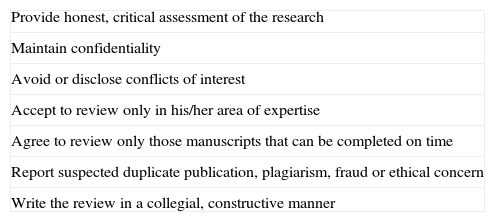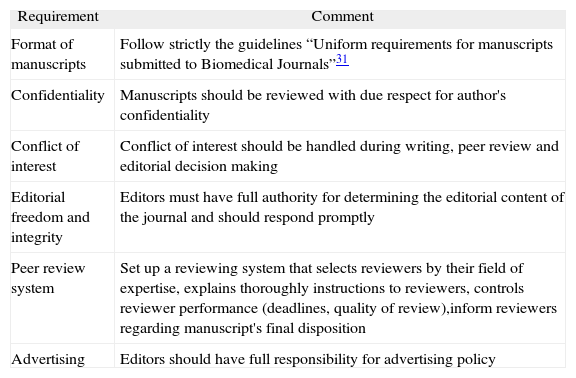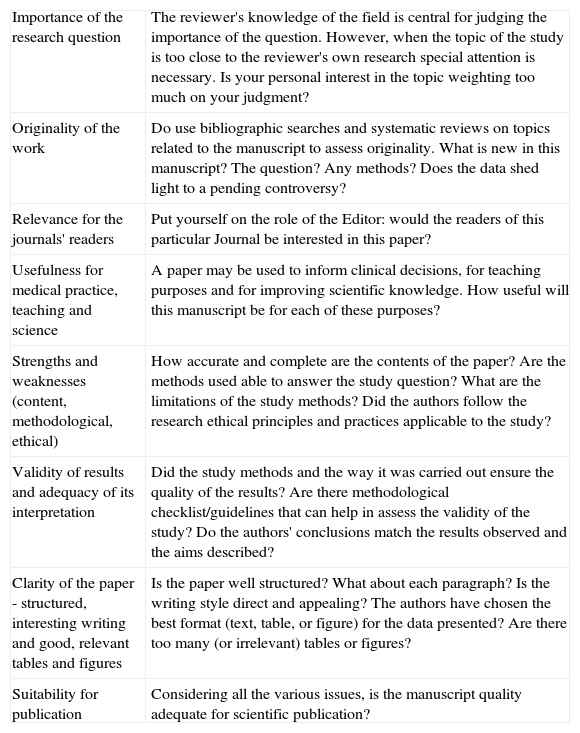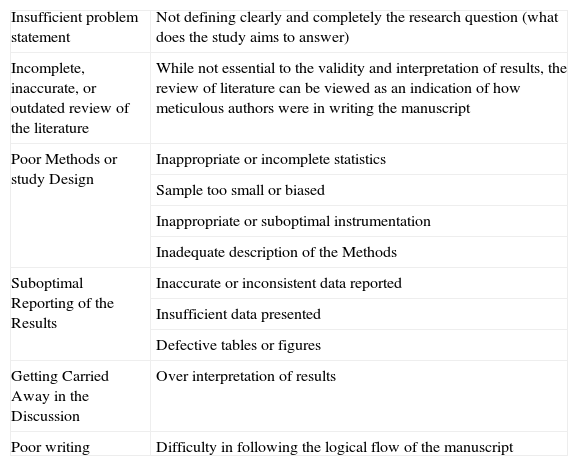The term peer review is used to describe a system whereby a paper is scrutinized by people who were not involved in its creation but are considered knowledgeable about the subject. 1 So it should be considered an evaluation by an expert on research of other experts in the same field.2 Although well recognized, unfortunately this technique is not formally taught but may improve with practice.
In the past 50 years the use of peer review has become the “gold standard” by which biomedical journals judge their papers. The first description of peer review took place in 1731 with a report from the Royal Society of Edinburgh.3 In 1893, the British Medical Journal and its editor Ernest Hart were among the first to implement a formal peer review system. However the necessity to implement this concept into medical journals took a long time, and only after the Second World War was peer review developed.4 With the specialization of medical journals many editors recognized this need and in 1986, Drummond Rennie 5 in response to a letter in the New England Journal of Medicine6 decided to organize a congress on Peer Review in Biomedical Publication. After this meeting in 1989, subsequent conferences took place adding to the considerable knowledge that we have today on this topic.7–12 As a result, research into the editorial processes has evolved and now became evidence based editing.13 Moreover the World Association of Medical Editors (www.wame.org) founded in 1995, was also created with the aim to foster international cooperation among and education of medical journal editors as well as to promote peer review as a quality assurance in medicine.14
Rationale of peer reviewThere is now evidence that peer review increases the quality of articles 15 and editors rely on peer reviewers to guarantee the appropriateness and scientific quality of the manuscripts they publish. However there is subjectivity in their role as demonstrated by studies showing lack of agreement between reviewers 16 and nationality biases (with US reviewers having a significant preference for US papers). 17 It is important that editors use grading instruments to assist in peer review and make formative assessment of their editorial competence. 18 Moreover use of several reviewers can also dilute the effects of a biased reviewer.
How are the reviewers chosen?It has been shown that the reviewers that produce the best-quality report tend to be younger, work at top academic institutions or are known to the editors. 19 More recently, another study has come to the same conclusion and has advised on recruitment of reviewers among those with training in epidemiology or statistics, and near 40 years of age. 20 Moreover spending more than 3 hours on a review did not increase review quality 19 and written feedback to reviewers (other reviewers' reports and the editor's decision letter) produced no improvement in performance.21 Of course one basic rule is that we should select reviewers who know the subject content of the work!
Although half-day workshop training did not improve subsequent review quality scores in average reviewers, 22 e-learning based and more intensive programs may be better and warrant investigation.
Most journal editors inherit a database of reviewers within different areas of expertise that can be expanded by identifying researchers with similar articles cited in MEDLINE. New electronic platforms allow the editor to track deadlines and record the performance of reviewers.
Typically Journal editors choose 2–3 reviewers, however having 2 or three reviews does no seem to change the rejection rate. 23
There is some general belief that masking the reviewers to the identification of the authors may improve quality of peer review. Apart from not being easy to do as units can be readily identified, the success rate is low 12,24 and the effect is negligible. 25 More recently some journals started to implement open peer review (where the identities of the author and the reviewer are known to each other) and the results are encouraging 26 although more research is needed on the value of open review and also if this inhibits especially younger reviewers from taking part.
Concerning reviewer selection, some journals also invite authors to suggest up to four suitable peer reviewers for their work. Indeed, examining the submission of original papers to Thorax, Hurst et al 27 have shown the outcomes were not much different though author selected reviewers tended to be more positive, the first decision was more likely to be positive and discordance with the editor's final decision was significantly higher.
The editors should choose reviewers to obtain a balance between content expertise, methodological expertise and educational relevance. 28
The reviewer has technical as well as ethical duties. Eight of the most important duties are summarized in Table 1 (adapted from ref 29).
Reviewer's duties
| Provide honest, critical assessment of the research |
| Maintain confidentiality |
| Avoid or disclose conflicts of interest |
| Accept to review only in his/her area of expertise |
| Agree to review only those manuscripts that can be completed on time |
| Report suspected duplicate publication, plagiarism, fraud or ethical concern |
| Write the review in a collegial, constructive manner |
So, the reviewer apart from wearing the hat of the journal's advocate should also wear the hat of the authors' advocate. 29
Good editorial practiceIn a study performed in 1992, including the top 100 US journals, it was concluded that the review process was not uniform!30 So establishing uniform editorial practices is a major task!
Good editorial practice is well defined in the “Uniform requirements for manuscripts submitted to Biomedical Journals”.31 Every journal should accept, apply and follow good editorial practice (summarized in Table 2).32
Good Editorial Practice
| Requirement | Comment |
| Format of manuscripts | Follow strictly the guidelines “Uniform requirements for manuscripts submitted to Biomedical Journals”31 |
| Confidentiality | Manuscripts should be reviewed with due respect for author's confidentiality |
| Conflict of interest | Conflict of interest should be handled during writing, peer review and editorial decision making |
| Editorial freedom and integrity | Editors must have full authority for determining the editorial content of the journal and should respond promptly |
| Peer review system | Set up a reviewing system that selects reviewers by their field of expertise, explains thoroughly instructions to reviewers, controls reviewer performance (deadlines, quality of review),inform reviewers regarding manuscript's final disposition |
| Advertising | Editors should have full responsibility for advertising policy |
Editorial decision-making should be directed at selecting the best manuscripts and those that better match their readership.
How to review a manuscript: practical tipsThe job of a reviewer is to assess the validity and importance of the work in the manuscript. The reviewers' reports will inform the decision of the journal editor that has the responsibility to accept or reject the paper. Reviewing a manuscript still remains a process based on the experience and personal background of the reviewer, as there is insufficient evidence to establish firm rules or recommendations. Nevertheless, different authors have put forward advices and practical tips based on experience. 2,33,34 Some of these practical tips are summarized below. While mostly directed to inexperienced reviewers these tips may drive experienced reviewers to critically reassess their practice. Also, authors can take them in consideration when planning, conducting and reporting their studies.
Decide prudently on accept/reject an invitationReviewing a paper is an opportunity to improve one's skills and an intellectual challenge. In some settings it is an activity with curricular value, in others an unrecognized, back-stage work. When an editor invites a prospective peer reviewer, he or she can be either tempted to hastily accept the invitation or reluctant in adding an extra task to a busy schedule. The knowledge in the field of the study, any conflicts of interest and the availability of time to do the review should be carefully considered before making a decision.
The pressure to have quick editorial decisions is very high. The success of a scientific journal rests heavily on the fast publication of good research papers. Therefore the time to deliver a review is now 2 to 4 weeks. The prospective peer reviewer should decline the invitation if he/she has doubts the deadline can be met. Three questions can be asked before accepting a review task - a) how familiar is the prospective peer reviewer with the research question and methods of the manuscript?; b) is there any conflict of interest such as personal relations with authors, competing research interests or any direct or indirect financial gain?, and c) does the prospective peer reviewer have the time to deliver the review report in the requested time frame?
Schedule enough time to the review before the deadlineAs in many human activities, experience reduces the amount of time necessary to complete a task. A review report can take 10 hours or more for an inexperienced reviewer. Trained reviewers take about 3 hours to produce their report. When accepting to review a paper, schedule ahead and keep your schedule!
Always remember the reviewer should help to improve the manuscriptThe reviewer should not act as an author, but has the responsibility to provide the authors with all comments and advices that helps the authors' work, even when suggesting the rejection of the manuscript. From time to time, the contribution of the reviewer is central for the success of a paper, for example by pointing out to the authors' new interpretation of the results improving the message of the paper.
Write reviews you would be satisfied with as an authorAlways explain your comments and present them in a logical, positive and polite way. Support with references whenever useful. The criticisms should be specific not vague. Be decisive; suggest the precise changes that would improve the sentence, paragraph, table, etc. It is also important to be realistic, the recommendation to redesign the study can seldom be achieved. Use a neutral tone, for example generalizations such as “never” or “always” are to be avoided as they are unproductive and author can often find examples that contradict the comment. When reviewing, state the facts, do not make assumptions or try to guess reasons. Remember to point out the positive aspects of the manuscript. This is helpful to the editor and fair to the authors. Examples of some of the most frequent positive reviewers' comments are: a) important, timely, relevant, critical, prevalent problem; b) well-written manuscript (clear, straightforward, easy to follow, logical), and c) well-designed study (appropriate, rigorous, comprehensive design).28
The manuscript is the only source of informationThe object of the review is the manuscript. The manuscript may also contain an on line supplement that needs to be assessed. The peer reviewer comments and recommendations should not consider previous or future work by the authors. No additional data or clarification is to be obtained from the authors during the review process. Also, one must assume what is reported closely describes what was planned and carried out during the study. If suspected otherwise the reviewer has the obligation to communicate his/her suspicions to the editor.
The manuscript is privileged informationThe manuscript contains new data and ideas that should be kept confidential before publication. Reviewers should not use the information in their own research or for personal gain. In the exceptional case of a colleague becoming involved in the review process this should be communicated to the editor at the start of the review and be acknowledge by the reviewer in the report to the editor.
Organize your review - follow a systematic processAddress systematically the issues the Journal includes in the reviewers instructions and forms. Keep your review process as objective as possible. A point-by-point critique will be clearer and will help the authors to reply to all comments. Table 3 lists the main issues that the review report should address and questions the reviewers may ask to help addressing them.29,35–38
Issues of manuscripts to assess during the review process and questions to address them (adapted from references 33, 39)
| Importance of the research question | The reviewer's knowledge of the field is central for judging the importance of the question. However, when the topic of the study is too close to the reviewer's own research special attention is necessary. Is your personal interest in the topic weighting too much on your judgment? |
| Originality of the work | Do use bibliographic searches and systematic reviews on topics related to the manuscript to assess originality. What is new in this manuscript? The question? Any methods? Does the data shed light to a pending controversy? |
| Relevance for the journals' readers | Put yourself on the role of the Editor: would the readers of this particular Journal be interested in this paper? |
| Usefulness for medical practice, teaching and science | A paper may be used to inform clinical decisions, for teaching purposes and for improving scientific knowledge. How useful will this manuscript be for each of these purposes? |
| Strengths and weaknesses (content, methodological, ethical) | How accurate and complete are the contents of the paper? Are the methods used able to answer the study question? What are the limitations of the study methods? Did the authors follow the research ethical principles and practices applicable to the study? |
| Validity of results and adequacy of its interpretation | Did the study methods and the way it was carried out ensure the quality of the results? Are there methodological checklist/guidelines that can help in assess the validity of the study? Do the authors' conclusions match the results observed and the aims described? |
| Clarity of the paper - structured, interesting writing and good, relevant tables and figures | Is the paper well structured? What about each paragraph? Is the writing style direct and appealing? The authors have chosen the best format (text, table, or figure) for the data presented? Are there too many (or irrelevant) tables or figures? |
| Suitability for publication | Considering all the various issues, is the manuscript quality adequate for scientific publication? |
A manuscript may be rejected at editorial level, before the editor sends it to reviewers. Often, the reasons for immediate rejection are being inappropriate for the journal's readers (wrong journal), not fitting ubmission. The paper will not be accepted if it addresses a topic outside the scope of the Journal or is in a style/format completely different from the rest of the Journal's content.38
After peer-review, the decision on the paper will depend on the comments presented by the reviewers and the editor's judgment about the priority for publication of the manuscript.
A few studies assessed the reasons for rejection of manuscripts in peer-reviewed journals.28,40–42
A summary of these reasons is presented in Table 4. Most of these reasons can be corrected by the authors when revising the manuscript. While unrelated to the study quality, poor writing style can have a strong influence on the overall impression of the manuscript by both reviewers and editors. The main issue in poor writing is difficulty in following the logical flow of the manuscript rather than grammar errors or language issues.
Frequent reasons supporting reviewers' recommendation for rejection of a manuscript (adapted from 26 and 38)
| Insufficient problem statement | Not defining clearly and completely the research question (what does the study aims to answer) |
| Incomplete, inaccurate, or outdated review of the literature | While not essential to the validity and interpretation of results, the review of literature can be viewed as an indication of how meticulous authors were in writing the manuscript |
| Poor Methods or study Design | Inappropriate or incomplete statistics |
| Sample too small or biased | |
| Inappropriate or suboptimal instrumentation | |
| Inadequate description of the Methods | |
| Suboptimal Reporting of the Results | Inaccurate or inconsistent data reported |
| Insufficient data presented | |
| Defective tables or figures | |
| Getting Carried Away in the Discussion | Over interpretation of results |
| Poor writing | Difficulty in following the logical flow of the manuscript |
An important reason for failure to publish a paper is not revising and resubmitting the manuscript after the peer review. Too often authors give up after the first rejection or just chose another journal to submit the manuscript. A second submission to the same journal, after careful revision of the paper (based on the reviewers' and editors comments) will substantially improve the quality of the paper.
Writing the reviewThe process of writing the review report is quite personal. As a reviewer gets experience establishes his/her own routine. We find the personal example described by Frederic G. Hoppin, Jr. very useful to the beginner.43
Today, the reviewing process usually starts with an email from the editor with an invitation to review a manuscript. General details of the paper are included in the email. Also, the time frame to conclude the review and a link to accept or refuse are provided. Before having access to the full paper, the prospective peer reviewer should consult with the editors about any potential conflict of interest. If the invitation is accepted, access to the full manuscript is provided. At this time, the reviewer should reassess if the full text of the manuscript changes the decision to accept (is the content different from the abstract? Is there a conflict of interest previously undetected?).
Before starting writing the review report a number of general questions help the reviewer to appraise the manuscript.44
- –
Why was the study done? Is it important?
- –
Have the authors adequately reviewed existing research?
- –
Does the work add enough to what is already in the published literature?
- –
Was there a clearly defined question?
- –
Was the design right for the question?
- –
Was the study ethical?
- –
Are the conclusions justified?
- –
Is there a clear message?
- –
Is it written in a clear, appealing style?
- –
Is this paper of interest to the readers of this journal?
In addition to these general questions it is very helpful to use specific checklists available to assess each study design. The EQUATOR network keeps updated resources on checklists and guidelines on reporting medical research literature.45
The review report is now usually performed online in a web application that often includes a review form, confidential comments to the editor (not available for the authors), the recommendation to the editor to accept or reject the paper and comments to the authors.
Most journals have a checklist or a form to be filled by the reviewer about the manuscript quality and its suitability/priority for publication in the Journal. This form aims to collect information more objectively and can help the reviewer to organize his/her opinions about the manuscript.
The “confidential comments to the editors” are a section of the review report not accessible to the authors. This is an opportunity for the reviewer to emphasize his/her views on why the manuscript is appropriate or not for that specific Journal. These comments should not repeat what was stated in the comments to the authors but rather to provide information to the editor to help his/her final decision.
The comments to the authors include the following:
- 1.
A brief, one-paragraph summary with the reviewer's interpretation of the work. This helps the editor to remember the essence of the manuscript and ensure the authors the reviewer understood it.
- 2.
The reviewer's recommendation to the editor; in general a manuscript can be considered acceptable to publication as is, with minor (optional) changes or with major (mandatory) changes or considered unsuitable for publication. If rejected, the reviewer can suggest the manuscript may be resubmitted to the same journal after correcting the problems identified. A useful global rating of the manuscript is: Accept, Accept Pending Revisions, Reconsider After Major Revisions, and Reject.36
- 3.
General comments. Mostly on the quality, importance and novelty of the manuscript. For example, “The study design is not adequate to the research question” or “The manuscript is well structured and written in a clear manner”.
- 4.
Specific comments. These are related to a particular part of the manuscript. For example, “The number of participants that completed the study are 86 in table 2 and 89 in the last sentence on page 2, paragraph 5. Please clarify”.
It is useful to address the issues in the manuscript in order of importance. Both general and specific comments can be organized in major and minor comments. Major comments include all the aspects that the reviewer feels need to be addressed before the paper is ready to be published.
A reviewer's comments should be direct, constructive and written as clear suggestions or observations. Avoid asking direct questions. These may result in answers by the authors without actual changes in the manuscript. Also, questions can have more than one answer making the authors uncertain on which answer the reviewer intended. The peer review is about the manuscript not the persons or groups who wrote it. Comments about the authors are inappropriate and do not contribute to the aims of peer-review. Also, the reviewer should try to minimize the influence of knowing the authors on the tone and contents of his/her comments.
ConclusionsAlthough peer review is not perfect and reviewers have a poor detection rate of errors in manuscripts,46 it is the only available method to improve the quality of published papers. Until now nobody has produced a satisfactory alternative to it! The “gold standard” for the quality of any paper remains time-whether it survives a dozen years to be incorporated into review articles or textbooks.47
Journal editors have to continually audit their procedures and apply the results of others to their own practices.47
Reviewers receive very little preparation for performing reviews as part of their formal education, and short training interventions do not seem to improve their performance.46
However in these times of materialism, it is encouraging that there are large numbers of professionals who are willing to offer many hours of their time to work without financial incentive! Peer review is an important service to the Medical and Research Communities. Participating in this process is valuable, voluntary work and, for the reviewer, is also an enjoyable task (most of the times at least).
In the case of the Portuguese Journal of Pulmonology we have to keep the tradition of respect, collegiality and empathy in all interactions during the Peer Review process. We have to feel honored and privileged to be selected as reviewers and to have the opportunity to interact constructively and make the work well.
As Bruce Squires stated about the creation of World Association of Medical Editors: “the fundamental purpose of medical journals (and their editors) should be to promote the science and art of medicine and the betterment of health”.14
Title of manuscript
|
Abstract and key-words
|
Introduction
|
| Participants and methods |
Study participants
|
Study design
|
Data collection methods
|
Variables description
|
Statistical analysis
|
Global assessment items
|
Results, tables and figures
|
Discussion
|
References
|
Global requirements
|
- Home
- All contents
- Publish your article
- About the journal
- Metrics
- Open access











